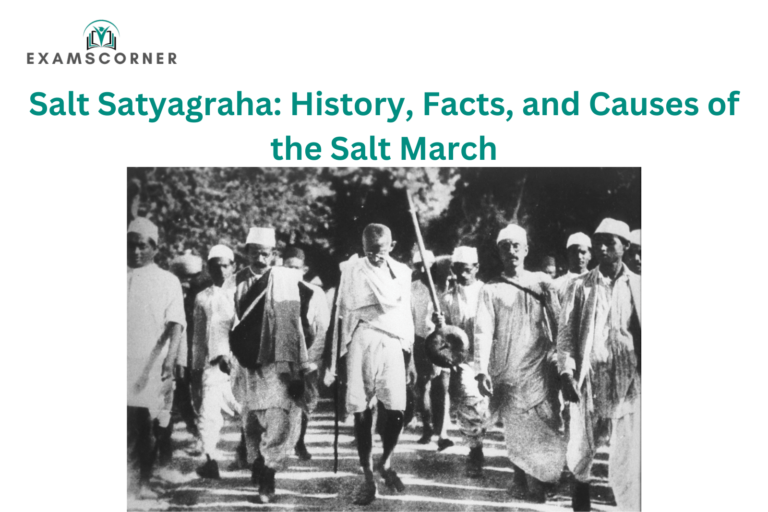The Salt Satyagraha, also known as the Salt March, Dandi March, or Dandi Satyagraha, was a pivotal act of nonviolent civil disobedience led by Mahatma Gandhi. This historic march, lasting from March 12, 1930, to April 6, 1930, was a direct protest against the oppressive British salt monopoly.
What Was the Salt Satyagraha?
The Salt Satyagraha was a mass civil disobedience movement organized by Mahatma Gandhi to challenge the salt tax imposed by the British government. It began on March 12, 1930, when Gandhi, along with a group of followers, embarked on a 24-day march from Sabarmati Ashram to Dandi, a coastal village in Gujarat, where they symbolically broke the salt law by producing salt from seawater.
Background to the Salt Satyagraha
By 1930, the Indian National Congress had declared Poorna Swarajya (complete independence) as the ultimate goal of India’s freedom struggle.
- Declaration of Poorna Swarajya Day:
- January 26 was observed as Poorna Swarajya Day.
- Civil disobedience was identified as the primary means to achieve independence.
- Choice of Salt as the Focal Point:
- Mahatma Gandhi chose the salt tax as the first act of defiance.
- This choice was initially met with skepticism from both Indians and the British, including members of Congress.
- Why Salt?
- Salt was essential to every Indian, particularly the poor, who were disproportionately affected by the salt tax.
- Under the 1882 Salt Act, Indians were prohibited from collecting or producing salt, making them reliant on heavily taxed British salt.
- Gandhi’s use of salt aimed to unite Indians, regardless of religion or class, in a shared grievance.
- British Revenue from Salt Tax:
- The salt tax accounted for 8.2% of British revenue in India, making it a critical source of income for the colonial government.
The Course of the Salt Satyagraha
Gandhi’s Announcement
On March 2, 1930, Gandhi informed Lord Irwin, the then Viceroy of India, about his intention to lead a peaceful march.
The March Begins
- Starting Point: Sabarmati Ashram on March 12, 1930.
- Participants: Gandhi began the march with 80 followers, who were instructed to remain nonviolent.
- Route: The march passed through several villages in Gujarat, where Gandhi addressed crowds, criticized British policies, and wrote articles for newspapers.
Reaching Dandi
- Arrival: Gandhi and his followers reached Dandi on April 5, 1930, by which time the march had grown to include 50,000 participants.
- Breaking the Salt Law: On April 6, 1930, Gandhi made salt by evaporating seawater, breaking the colonial law. Thousands of Indians followed suit, symbolically defying British authority.
Effects of the Salt Satyagraha
Mass Participation
- Over 60,000 people, including Gandhi, were arrested.
- The movement inspired widespread civil disobedience across India, targeting:
- The salt tax.
- Other oppressive taxes, including the forest laws, chowkidar tax, and land tax.
Spread of Satyagraha
- Prominent leaders initiated similar marches across the country:
- C. Rajagopalachari led a march from Trichy to Vedaranyam in Tamil Nadu.
- K. Kelappan led a march in Kerala from Calicut to Payyanur.
- In Assam and Andhra Pradesh, salt was produced illegally.
- In Peshawar, the movement was led by Khan Abdul Ghaffar Khan, whose followers (Khudai Khidmatgars) faced brutal suppression.
Women’s Involvement
- Thousands of women actively participated in picketing liquor shops, boycotting foreign goods, and producing salt.
Protests Against British Authorities
- On May 21, 1930, Sarojini Naidu led a nonviolent protest at the Dharasana Salt Works, where police brutally attacked protestors, killing two and injuring many.
- The international media reported these events, leading to widespread condemnation of British policies.
British Response
- The Congress Party was declared illegal.
- The government implemented censorship and passed stricter laws, but the nonviolent nature of the movement made it difficult to suppress.
Significance of the Salt Satyagraha
- Global Recognition:
- The movement brought the Indian freedom struggle into the limelight, especially in Western media.
- Mass Mobilization:
- For the first time, large sections of Indian society, including women and marginalized communities, actively participated in the independence movement.
- Strengthening Satyagraha:
- Demonstrated the power of nonviolent resistance as a tool against imperialism.
Outcome of the Salt Satyagraha
Gandhi-Irwin Pact (1931)
- Gandhi was released from prison in 1931 and entered into negotiations with Lord Irwin.
- Key agreements:
- The civil disobedience movement would end.
- Indians would be allowed to produce salt for personal use.
- The British agreed to release arrested Indians.
- Gandhi also participated in the Second Round Table Conference in London as an equal representative of India.
Drawbacks of the Salt Satyagraha
- Limited Concessions:
- The movement did not result in significant immediate gains from the British government.
- Limited Muslim Support:
- The movement failed to garner widespread support from Muslim leaders and communities.
Conclusion
The Salt Satyagraha was a defining moment in India’s freedom struggle, showcasing the power of nonviolent resistance and inspiring millions to join the movement. Although it had its limitations, the march significantly weakened the British moral authority and drew global attention to India’s fight for independence. The legacy of the Salt Satyagraha continues to inspire movements for justice and equality worldwide.



